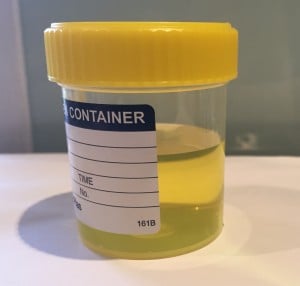There’s nothing quite like having an adult pet that you know is house-trained but is suddenly leaving urine dribbles all over the house. Is she doing it on purpose? Does she just not want to go outside in the morning because “she doesn’t want to get her feet wet”? Or is there something else going on?
Urinary Incontinence is a condition where the urine leaks from the bladder and is not under your pet’s control – it’s involuntary. There are a variety of causes of urinary incontinence including anatomical, neurological or hormonal causes. There are also some conditions which can be confused with urinary incontinence that need to be eliminated from the list of possible reasons for your pet’s problem: a pet with cystitis (an infection in the bladder where the urge to urinate is very strong so the pet wees in unusual places); submissive urination (your young dog wees when it gets a fright or excited); a dog or cat that has not been desexed and is marking it’s territory; a young pet that just needs a little more housetraining; an old pet that is suffering from cognitive dysfunction and has forgotten its house-training; a pet with arthritis that finds it too painful to navigate the litter tray or stairs…
So, what are the causes of a leaky bladder?
Anatomical and Physical
- Young animals that are born with ectopic ureters. This is when the little tube, the ureter, that normally carries urine from the kidney to the bladder opens instead into the urethra or vagina and bypasses the bladder completely. Vulvovaginal stenosis is another condition that occurs in female dogs where some urine gets trapped in the vagina because of a narrowed opening, which then dribbles out at a later stage.
- Older pets may lose some of their muscle mass and strength in the muscles surrounding the urethra. This can be worse if they are obese or on days when they have have over-exerted themselves.
- Pets with a partial blockage of the urethra (e.g. a little growth or bladder stone) may experience incontinence because of urine leaking around the blockage.
Neurological
- Brain or spinal cord injuries or disease may cause problems with passing urine. Either they are unable to pass urine or it dribbles out involuntarily. Usually there are other neurological signs like weak or paralysed muscles at the same time.
Hormonal
- Hormone-responsive incontinence occurs in desexed dogs of both sexes and rarely in desexed cats, but most often in desexed female dogs. They are able to urinate normally but will leak urine when resting. The exact mechanism of action involved has not been discovered as yet, but with medication these pets usually respond very well and their condition can be managed effectively.
Other
- Infectious causes: Feline leukaemia virus has been reported as a cause in both male and female cats.
- Chronic overfilling of the bladder as a result of kidney disease, Cushing’s Disease, Diabetes or chronic bladder infections, can actually damage the muscle layers of the bladder wall and impair its normal function resulting in leaking urine.
How is Urinary Incontinence diagnosed?
- A vet visit is the only way this condition can be diagnosed. You will be asked specific questions about when the urination occurs, if your dog is aware of it happening, what their activity and behaviour has been like? You will be asked if they have any long term medical conditions or if they are taking any medication? Have they had any previous surgeries or injuries? You need to give as much information as possible.
- A physical exam will be performed to look for evidence of disease or organ dysfunction.
- A urine sample will need to be evaluated to decide if the kidneys are concentrating the urine properly, if there is any sign of infection or bladder crystals or stones. The urine sample may need to be cultured if there is a possibility of an infection.
- Blood tests may be required if there is a possibility of organ dysfunction.
- Radiographs (X-rays) or an ultrasound exam may be required if certain conditions are suspected.
How is Urinary Incontinence Treated?
Depending on the cause of the incontinence, the attending vet will explain the appropriate treatment.
Surgery may be curative in some conditions e.g. a small polyp removed from the bladder. Whereas closer management of underlying disease e.g. Diabetes, results in improved continence.
When other causes have been eliminated, some medications may be given to improve the tone of the muscle sphincter that controls the flow of urine from the bladder. These medications include some hormone-replacement drugs and this condition is referred to as ‘Hormone-Responsive Urinary Incontinence’. There are a couple of options and some animals respond better to one drug than another, so more than one trial may be required. These pets need to stay on this medication life-long but it allows them, and their owners, a better quality of life.
If you would like any further information or suspect your pet may have a ‘leaky bladder’, please call 0481 527 678 or book an appointment online to get your pet checked out.

